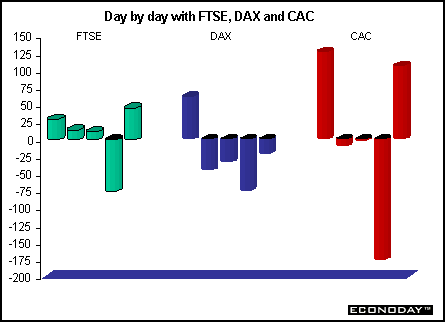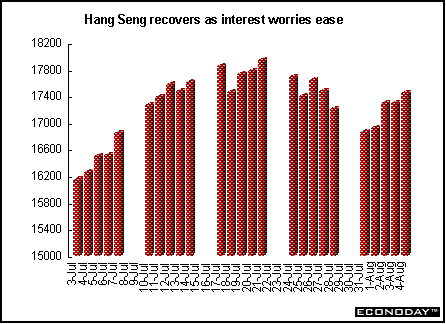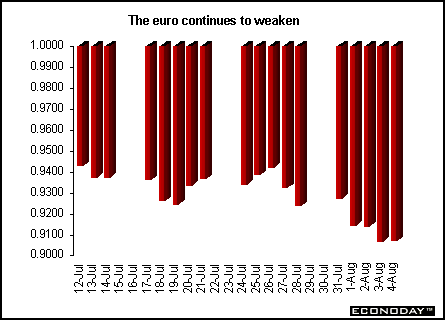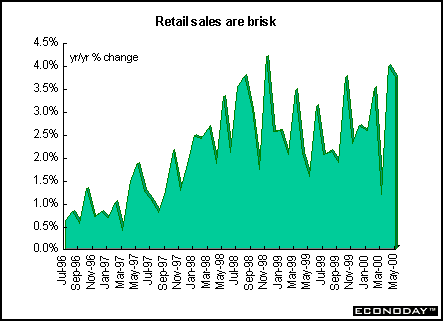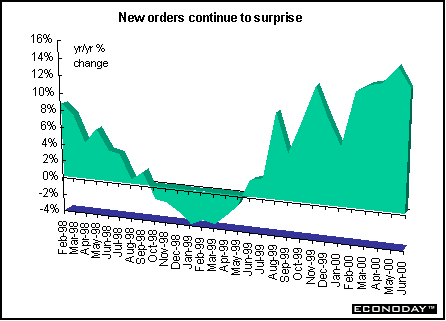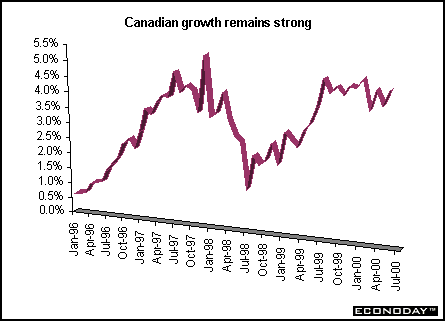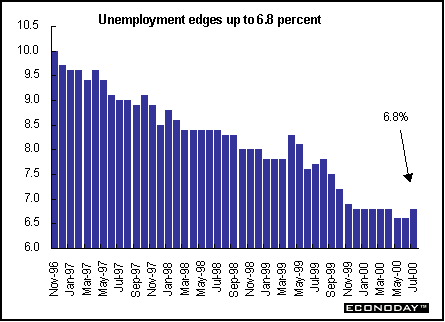| Previous Articles |
|
Thin volumes accentuate volatility
The week was dominated by anticipation of the two central bank meetings as well as the U.S. and European purchasing managers' surveys, and U.S. employment data. Low turnover as befits August exacerbated intra-day movements. And once again overseas investors traded in their home markets but had their eyes on the Dow and Nasdaq for direction as earnings reports and outlooks unfolded. Technology stocks were particularly volatile as investors worried about the impact of slower growth on second half earnings. North American markets outperformed those in Asia and Europe. The Dow was up 2.44 percent, the Nasdaq was up 3.40 percent, the TSE composite was up 2.17 percent and the Mexican Bolsa was up 3.76 percent.
Britain and Europe
Even though the BOE and ECB meetings were over, continued uncertainty about global interest rates left equity markets trading cautiously. The banks' interest rate decisions did not resolve the market's dilemma over monetary policy. The risk is always that if action is not pre-emptive it has to be more aggressive. The markets chose to ignore the latest decisions once they were made and shifted their immediate worries to the U.S. employment report.
British and European markets ended the week more or less where they began. The London FTSE 100 was up 27.80 points or 0.44 percent to end the week at 6363.5. The Paris CAC, thanks to a turnaround in technology stocks, closed a very volatile week at 6461.35, up 45.62 points or 0.71 percent. But the Frankfurt DAX ended the week at 7016.59, down 111.71 points or 1.57 percent.
Asia The latest figures from the Tokyo Stock Exchange revealed that foreigners were once again net sellers of Japanese equities in the week ending July 28.
Hong Kong investors continue to fret about interest rates. Hong Kong interest rates track those in the United States because the Hong Kong dollar is pegged to the U.S. dollar. And higher rates crimp their earnings outlook and have a dampening effect on stocks. Banks and developers should be more optimistic because of the weaker than expected U.S. jobs report. The data suggested that U.S. economy is slowing down and the U.S. Federal Reserve may soon be finished raising rates.
Despite its worries, the Hong Kong Hang Seng index ended the week at 17,425.70, up 241.77 points or 1.41 percent. The index also rose on the improved macro economic outlook for mainland China.
Currencies The euro has been under pressure since last week, when strong U.S. gross domestic product figures for the second quarter dampened expectations of a U.S. economic slowdown. Investors had assumed that as the U.S. economy cooled and the EMU picked up, growth levels would converge. But signs of renewed U.S. economic vigor overshadowed continued solid EMU economic data. (See indicator scoreboard below.) For example, the European Commission's index of consumer and business confidence held steady at a 10 year high in July. Analysts say that data which simply meets expectations generally fails to move currency markets - and everyone knows already about the good news in the EMU.
The euro is also suffering from the continuing efforts by European companies to bolster their competitiveness and gain access to the U.S. market by buying American companies. Those deals effectively require European companies to buy dollars thereby supporting the U.S. currency.
Early in the week the yen weakened against the dollar because of the government's political and economic woes and loss of momentum in the stock market. Weak consumer spending data also hit the Japanese currency. (See indicator scoreboard below.) Political uncertainty deepened after revelations that a cabinet minister had received political donations which exceeded the amount legally allowed.
The bad news was offset by exporters looking to complete much of their hedging requirements up to September, the end of the Japanese fiscal half year. Bank of Japan Governor Masaru Hayami reiterated the bank's intention to raise interest rates, possibly as soon as this Friday's meeting. Governor Hayami emphasized that ending the zero interest rate policy (ZIRP) would not mean that the bank is shifting to a restrictive monetary policy.
However, the market will still have to focus on Japan's fundamentals, including dismal stock market performance, a mountain of potential corporate bankruptcies, an iffy political leadership and, perhaps most importantly, economic data showing limited domestic activity.
Indicator scoreboard May merchandise trade surplus with the rest of the world was E0.1 billion, down from the E1.5 billion surplus of last year. Exports were up 34 percent and imports jumped 38 percent when compared with last year.
May real retail sales rose 0.2 percent and 3.7 percent when compared with last year. The series is highly volatile and methodologies vary in different countries, which makes cross country comparisons difficult.
July seasonally adjusted purchasing managers' index slipped to 59.2 from 59.5 in June. A level above 50 indicates that the manufacturing sector is expanding, while a level below 50 indicates contraction. Despite the gradual drift lower in the PMI over the past three months, the July reading shows that EMU manufacturing activity continues to be buoyant. The prices index, which is not part of the overall PMI, eased in July to 72.0 from an upwardly revised 72.7 in June. This was the second straight decline, indicating that price pressures are easing. The EMU PMI is based on results from Germany, France, Italy, Spain, Ireland and Austria.
The July European Commission's economic sentiment index for the EMU remained at an all time high of 104.0 for the fifth month. Overall economic sentiment rose in four of the EMU countries - Italy, Portugal, Austria, Finland - and fell in all others.
June industrial producer prices - excluding construction - rose 0.4 percent on the month and 5.6 percent when compared with last year. The main factor behind the strong overall PPI increase was a 1.0 percent monthly and 12.0 percent annual increase in intermediate goods prices. This category contains prices for oil and other commodities, which were also strongly affected by the weak euro.
Germany - June real seasonally adjusted wholesale sales fell 2.5 percent and 1.6 percent when compared with last year. In the first six months of 2000, wholesale sales rose by 5.4 percent in real terms and by 11.1 percent in nominal terms compared to the same period last year. The latest data show that the overall 3.9 percent year over year gain in nominal wholesale sales was due entirely to price increases. June manufacturing orders rose 0.4 percent with a gain in foreign demand more than offsetting a drop in domestic demand. Domestic manufacturing orders fell 0.4 percent, but that decline was more than offset by a 1.6 percent rise in foreign orders. Orders for west German manufactured goods rose 0.6 percent but demand for east German products fell 1.9 percent.
France - The increase in the June producer price index eased to 0.5 percent after an 0.8 percent increase in May, for a gain of 6.1 percent on the year. The PPI base-year has been changed to 1995 from 1990 and weightings have been updated. June energy prices rose 1.7 percent and 29.6 percent when compared with last year primarily because of increased fuel prices. Excluding energy and food, the core PPI rose 0.1 percent on the month and 2.2 percent when compared with last year. Italy - June producer prices rose 0.5 percent and 6.9 percent when compared with last year. The increase was entirely due to energy prices. May industrial orders were up 16.9 percent when compared with last year. The strong gain was well balanced between foreign orders (up 16.7 percent) and domestic orders (up 17.0 percent). Spain - June nominal producer prices rose 0.3 percent on the month and 5.8 percent on the year due largely to higher prices for oil refining and related products. Energy prices rose 2.6 percent on the month and 25.2 percent on the year. Britain - June net consumer credit growth slowed to Stg967 million compared with a record Stg1.538 billion increase in May. In percentage terms, consumer credit was up 0.8 percent on the month and 13.8 percent on the year. July Nationwide seasonally adjusted house price index fell 0.2 percent on the month but was still up 13.9 percent from a year earlier. Over the past three months housing prices have remained broadly unchanged.
Total seasonally adjusted housing starts in the three months to June fell 4 percent vs. the previous quarter but rose 1 percent when compared with last year. Total completions in the second quarter fell 1 percent on the quarter but were unchanged on the year. Total construction new orders in the three months to June were 9 percent higher than in the previous three months and rose 8 percent on the year. Asia Australia - June private sector credit grew by 1.4 per cent and 13.1 percent when compared with last year. Personal and household credit both increased by 17.5 per cent. Credit to business rose a more moderate 8.7 per cent. June retail sales posted a record 7.7 percent gain. The increase in spending to A$13.2 billion (US$7.6 billion) came after a 0.3 percent increase in May. In the second quarter, sales rose 2.7 percent, following a record 1.5 percent decline in the first quarter. Department store retail sales soared 17.2 percent. Americas
July unemployment rate rose to 6.8 percent from 6.6 percent in June. Full time employment was little changed in July while part time employment declined by 23,000. Total employment edged down slightly (17,000) for the second consecutive month. Since March, monthly employment growth has averaged 4,000, much slower than the average monthly growth of 44,000 in the preceding six months.
BOTTOM
LINE
Release dates are subject
to change. |
|||||||||||||||||||||||||||||||||||||||||||||||||||||||||||||||||||||||||||||||||||||||||||||||||||||||||||||||||||||||||||||||||||||||||||||||||||||||||||||||||||||||||||||||||||
